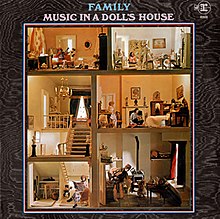Music in a Doll's House
| Music in a Doll's House | ||||
|---|---|---|---|---|
 | ||||
| Studio album by | ||||
| Released | 19 July 1968 | |||
| Recorded | December 1967 – early 1968 | |||
| Studio | Olympic Studios, London | |||
| Genre | Psychedelia,[1] Progressive rock | |||
| Length | 37:00 | |||
| Label | Reprise | |||
| Producer | Dave Mason | |||
| Family chronology | ||||
| ||||
| Review scores | |
|---|---|
| Source | Rating |
| AllMusic | |
| Rolling Stone | (neutral)[3] |
| Encyclopedia of Popular Music | |
Music in a Doll's House is the debut album by English progressive rock group Family, released on 19 July 1968. The album, co-produced by Dave Mason of Traffic,[5] features a number of complex musical arrangements contributing to its ambitious psychedelic sound.
Background[]
The Beatles had originally intended to use the title A Doll's House for the double album they were recording during 1968.[citation needed] The release of Family's similarly titled debut then prompted them to adopt the minimalist title The Beatles for what is now commonly referred to as the "White Album" due to its plain white sleeve.
"Old Songs, New Songs" features a cameo from the Tubby Hayes group, arranged by 18-year-old Mike Batt. Hayes played the tenor sax solo at the end of the track (uncredited). Batt also arranged and conducted other strings and brass for the album, notably "The Chase" and "Mellowing Grey" but was not credited.[citation needed]
The album was the first of its kind by an English rock group on the US Reprise label set up for Frank Sinatra (but was already part of Warner Bros). It was licensed to the label by Dukeslodge Enterprises, a company run by the band's manager, John Gilbert, who also acted as 'executive producer' of the album. The album was released on vinyl in two different guises: mono (RLP6312) and stereo (RSLP6312) and Stereo 8 Track Cartridge. Mono vinyl copies featured a different mix to the stereo pressing and many mono copies were returned to the shops as they often skipped tracks. The mono edition was swiftly withdrawn, making this a much sought-after format.[citation needed]
This album was initially issued in the US using the UK import and sold in the US as a domestic album with an extra piece of cardboard to stiffen the sleeve (as they essentially had the same catalog number in both countries). Around the time the second album was issued in the US, US pressings of this album started to appear. (The album also initially had a 12" black and white photo of group included as an insert.)
In the Q & Mojo Classic Special Edition Pink Floyd & The Story of Prog Rock, the album ranked number 30 in its list of "40 Cosmic Rock Albums".[6] It was voted number 606 in the third edition of Colin Larkin's All Time Top 1000 Albums (2000).[7]
Track listing[]
All tracks written by John Whitney and Roger Chapman, except as noted.
| No. | Title | Writer(s) | Length |
|---|---|---|---|
| 1. | "The Chase" | 2:13 | |
| 2. | "Mellowing Grey" | 2:48 | |
| 3. | "Never Like This" | Dave Mason | 2:18 |
| 4. | "Me My Friend" | 2:01 | |
| 5. | "Variation on a Theme of Hey Mr. Policeman" (instrumental) | 0:23 | |
| 6. | "Winter" | 2:26 | |
| 7. | "Old Songs for New Songs" | 4:17 | |
| 8. | "Variation on a Theme of The Breeze" (instrumental) | 0:40 | |
| 9. | "Hey Mr. Policeman" | Whitney, Ric Grech, Chapman | 3:13 |
| 10. | "See Through Windows" | 3:43 | |
| 11. | "Variation on a Theme of Me My Friend" (instrumental) | Whitney | 0:22 |
| 12. | "Peace of Mind" | 2:22 | |
| 13. | "Voyage" | 3:35 | |
| 14. | "The Breeze" | 2:50 | |
| 15. | "3 x Time" | 3:34 | |
| 16. | "God Save the Queen" (hidden track) | 0:14 |
Personnel[]
Family[]
- Roger Chapman – vocals, harmonica, tenor saxophone
- John "Charlie" Whitney – lead and steel guitars
- Jim King – tenor and soprano saxophones, vocals, harmonica
- Ric Grech – bass guitar, vocals, violin, cello
- Rob Townsend – drums, percussion
Technical[]
- Dave Mason – producer, Mellotron
- Jimmy Miller – co-producer on "The Breeze" and "Peace of Mind"
- John Gilbert – executive producer
- Eddie Kramer – engineer
- George Chkiantz – second engineer
- Peter Duval – album design
- Julian Cottrell – front cover photography
- Jac Remise – back cover photography
References[]
- Sleevenotes from CD re-release of album on See For Miles Records
- Notes
- ^ Prendergast, Mark (2003). The Ambient Century: From Mahler to Moby – The Evolution of Sound in the Electronic Age. New York, NY: Bloomsbury. pp. 226–27. ISBN 1-58234-323-3. "A quintessential UK psychedelia album".
- ^ Planer, Lindsay (2011). "Music in a Doll's House - Family | AllMusic". allmusic.com. Retrieved 25 June 2011.
- ^ Gancher, David (December 7, 1968). "Records". Rolling Stone. San Francisco: Straight Arrow Publishers, Inc.
- ^ Larkin, Colin (2011). Encyclopedia of Popular Music (5th ed.). Omnibus Press. p. 3074. ISBN 978-0857125958.
- ^ Vernon Joynson, The Tapestry of Delights Revised, The Comprehensive Guide To British Music Of The Beat, R&B, Psychedelic and Progressive Eras 1963 - 1976, 2006 Edition (Borderline Productions, Reprinted 2008), pp. 276
- ^ Q Classic: Pink Floyd & The Story of Prog Rock, 2005.
- ^ Colin Larkin, ed. (2000). All Time Top 1000 Albums (3rd ed.). Virgin Books. p. 202. ISBN 0-7535-0493-6.
- Family (band) albums
- 1968 debut albums
- Albums produced by Dave Mason
- Albums produced by Jimmy Miller
- Reprise Records albums